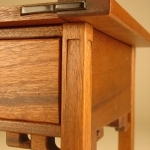What is the best design for the bottom of a cedar chest? I’m designing and going to build a chest, but I notice many different bottoms. The first one I found simply glued a glued-up board inot rabbets, allowing no room for wood movement. Second, a guy put 3/8″ plywood in rabbets, and then he glued 1/4″ aromatic cedar over top. Third, the traditional Shaker design in Fine Woodworking archives actually has a frame and two-panel bottom. And so it goes. Do you have any opinion on what is best?
Thanks,
Jim Bell
















Replies
The best design, assuming you want this piece to last a couple of hundred years, is a raised panel assembly.
Support our Troops. Bring them home. Now. And pray that at least some of the buildings in the green zone have flat roofs, with a stairway.
jim,
The period blanket chests I've seen typically have board bottoms, either frankly nailed onto the bottom edge of the case, or let into the inside of the case (usually not in a rabbet) and held there with nails or wooden pins driven through the face of the case. I've seen bottoms made from fairly narrow boards, tongue and grooved together (not glued).
Wood movement is an issue especially if the boards are let into the case, as there will be a gap when the bottom shrinks, or pressure, maybe enough to push the corners of the case apart, when the bottom swells. Nailing the bottom onto the case can be effective, if the joint is covered by a base mold that is applied to the case, and allowance is made for the movement that will occur behind the molding. Narrower boards tongue and grooved together divides up any movement among the boards. The drawback is that the gaps between the boards in their shrunken state can catch debris and dirt, though this is not really an issue inside a closed case.
I've not personally seen a frame and panelled bottom in a blanket chest, although chests with drawers below often have their (solid) bottoms let into a groove, with allowance for movement.
Regards,
Ray
Thanks for the replies. I'm going to glue up a bottom of aromatic cedar, run a groove/dado all around the carcase, and then glue the bottom in at the front only. (The tongue and groove idea is also appealing, especially if I put a dot of glue on the end of each board as I put it in the groove/dado, but the rest of the chest will be butt joined glue up, so I think I'll just continue that for the bottom.) Thanks, again.
Jim Bell
This forum post is now archived. Commenting has been disabled